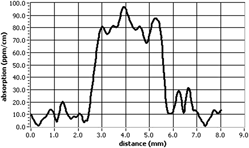Crossref Citations
This article has been cited by the following publications. This list is generated based on data provided by
Crossref.
Cabrini, Stefano
Lérondel, Gilles
Schwartzberg, Adam M.
Mokari, Taleb
Baker, C.
Kim, W.
Friebele, E. J.
Villalobos, G.
Frantz, J.
Shaw, L. B.
Sadowski, B.
Fontana, J.
Dubinskii, M.
Zhang, J.
and
Sanghera, J.
2014.
Synthesis of high purity metal oxide nanoparticles for optical applications.
Vol. 9161,
Issue. ,
p.
91610D.
Kazemi, Alex A.
Kress, Bernard C.
Mendoza, Edgar A.
Bayya, Shyam
Villalobos, Guillermo
Kim, Woohong
Sanghera, Jasbinger
Hunt, Michael
and
Aggarwal, Ishwar D.
2014.
Rugged sensor window materials for harsh environments.
Vol. 9202,
Issue. ,
p.
92021D.
Kim, Woohong
Villalobos, Guillermo
Baker, Colin
Frantz, Jesse
Shaw, Brandon
Bayya, Shyam
Bowman, Steven
Sadowski, Bryan
Hunt, Michael
Rock, Benjamin
Aggarwal, Ishwar
and
Sanghera, Jasbinder
2015.
Overview of transparent optical ceramics for high-energy lasers at NRL.
Applied Optics,
Vol. 54,
Issue. 31,
p.
F210.
Vizgaitis, Jay N.
Andresen, Bjørn F.
Marasco, Peter L.
Sanghera, Jasbinder S.
Snyder, Miguel P.
Bayya, Shyam
Villalobos, Guillermo
Hunt, Michael
Kim, Woohong
Plunkett, Simon
and
Sanghera, Jasbinder
2016.
Rugged spinel optics for space based imaging systems.
Vol. 9822,
Issue. ,
p.
982204.
Jung, Wook Ki
Ma, Ho Jin
Kim, Ha-Neul
and
Kim, Do Kyung
2018.
Transparent Ceramics for Visible/IR Windows: Processing, Materials and Characterization.
Korean Journal of Materials Research,
Vol. 28,
Issue. 10,
p.
551.
Balabanov, S. S.
Belyaev, A. V.
Novikova, A. V.
Permin, D. A.
Rostokina, E. Ye.
and
Yavetskiy, R. P.
2018.
Densification Peculiarities of Transparent MgAl2O4 Ceramics—Effect of LiF Sintering Additive.
Inorganic Materials,
Vol. 54,
Issue. 10,
p.
1045.
Ma, Jessica
Airola, Marc B.
Thomas, Michael E.
Spicer, James
and
Poisl, W. Howard
2019.
Measurements of weak scattering and absorption in spinel and sapphire from the near infrared to the visible.
p.
1.
Qadri, Syed Noor
Bayya, Shyam S.
Villalobos, Guillermo
Kim, Woohong
Hunt, Michael
Busse, Lynda E.
Frantz, Jesse A.
Shaw, L. Brandon
Sanghera, Jasbinder S.
Sadowski, Bryan
Miklos, Robert
Aggarwal, Ishwar D.
Wilson, Christopher R.
and
Poisl, W. Howard
2019.
Spinel optics for high energy lasers.
p.
8.
He, Yu
Liu, Kaige
Xiang, Bingxi
Zhou, Chaolan
Zhang, Ling
Liu, Gang
Guo, Xiaoyang
Zhai, Jianpang
Li, Tao
and
Kong, Ling Bing
2020.
An overview on transparent ceramics with pyrochlore and fluorite structures.
Journal of Advanced Dielectrics,
Vol. 10,
Issue. 03,
p.
2030001.
Azizi-Malekabadi, Masoud
and
Sarraf-Mamoory, Rasoul
2020.
Devising a novel method of producing high transparent magnesium aluminate spinel (MgAl2O4) ceramics body using synthesized LiF nanopowder and spark plasma sintering.
Materials Chemistry and Physics,
Vol. 250,
Issue. ,
p.
123035.
Mader, Markus
Prediger, Richard
Schell, Karl G.
Schmidt, Gabriela
Dorn, Alex
Jenne, Sophie
Kluck, Sebastian
Hambitzer, Leonhard
Luitz, Manuel
Schwarz, Claudia
Milich, Marcel
Greiner, Christian
Rapp, Bastian E.
and
Kotz‐Helmer, Frederik
2022.
Injection Molding of Magnesium Aluminate Spinel Nanocomposites for High‐Throughput Manufacturing of Transparent Ceramics.
Advanced Science,
Vol. 9,
Issue. 31,
Luo, Haoming
Han, Dan
Zhang, Jian
and
Wang, Shiwei
2024.
Magnesium aluminate spinel transparent ceramics with high optical and mechanical performance by Y3Al5O12 sintering additive.
Journal of the American Ceramic Society,
Vol. 107,
Issue. 9,
p.
6224.
